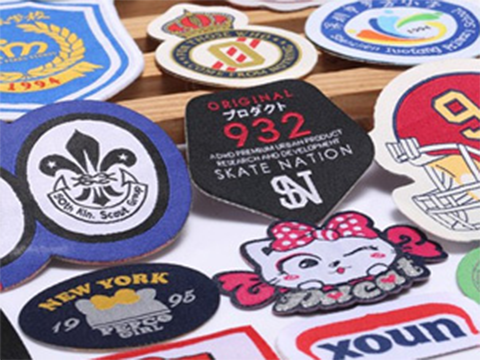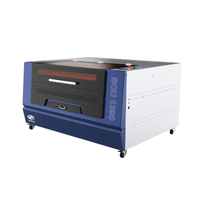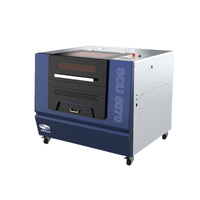
CO2 lasers differ from fiber lasers in the wavelength of light, which significantly increases the range of materials that can be processed with it.
The most popular materials are: wood, plastics such as PMMA (plexiglass), fabrics, rubber, stone, glass as well as steel and coated non-ferrous metals.
Once the most popular co2 lasers used the power in the kilowatt range and were mainly used for cutting out thick sheet metal.
With time, small office lasers with a power of 40-80W were produced, mainly used as engraving machines.
Now the most popular models have a power of 100-150W, and in addition to the possibility of engraving like models with lower power, they can cut quite thick materials 15- 20mm (50mm) and steel up to a thickness of 2mm.
Cutting thick materials results in a loss of accuracy due to the need to use lenses with a longer focal length. For example, for a material with a thickness of up to 3mm, you can use a lens with a focal length of 1.5 "and we will get an accuracy of 0.08mm, while for a material with a thickness of 15mm we will use a lens with a focal length of 4" and the accuracy will drop to 0.35mm.
The materials that can be processed with a CO2 laser are divided into two categories:
Materials that we can cut:
all kinds of plastic! however, it should be remembered that many of these materials generate poisonous vapors and gases (such as the popular polycarbonates, PVC). The harmfulness of a given material can very much depend on its color - the ingredients of the dye used in its production!
wood and its derivatives (the quality of the cut, the maximum thickness very much depends on the type of wood, its dryness, or the glue used)
fabrics
acrylic
wood
paper
plywood
leather
ABS
rubber
foam
Cardboard
Materials that can be engraved:
all types of plastics (subject to harmfulness as when cutting)
wood and its derivatives (you can get the effect of a relief with a variable depth of engraving)
glass
stone
Crystal
MDF Plated
Silicone
Cardboard
Fabric
CO2 laser machines have a wide range of applications across various industries, including:
Industrial Cutting and Engraving: CO2 laser machines are commonly used for high-precision cutting and engraving of various materials such as wood, acrylic, leather, fabric, paper, and plastic. They offer excellent control and can produce intricate designs with high accuracy.
Medical Applications: CO2 lasers are widely used in the medical field for procedures such as skin resurfacing, scar removal, and the treatment of various skin conditions. They provide quick and efficient results with minimal downtime.
Metal Processing: CO2 lasers can also be used for cutting and welding of metals, especially non-ferrous metals like aluminum and stainless steel. They offer a precise and controlled method for metal fabrication and are often used in industries like automotive, aerospace, and jewelry.
Marking and Etching: CO2 lasers can be used to mark and etch on a variety of materials such as glass, ceramics, stone, and plastics. They enable permanent and precise markings for product labeling, branding, or customization purposes.
Textile and Apparel Industry: CO2 lasers are used for cutting fabrics and textiles, providing clean and sealed edges without fraying. They are also used for intricate pattern cutting and engraving on garments and accessories.
Electronics Manufacturing: CO2 lasers play a crucial role in the manufacturing of electronic components and circuit boards. They are used for precision cutting, drilling, and marking processes in the semiconductor industry.
Prototyping and Artistic Applications: CO2 lasers are utilized in rapid prototyping for architectural models, product design, and artwork. They allow for precise and intricate fabrication of designs on various materials.
These are just some of the many applications of CO2 laser machines. Their versatility and precision make them a popular choice in various industries that require cutting, engraving, marking, or welding processes.







































